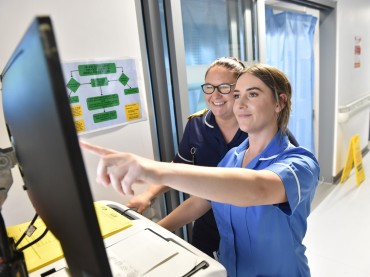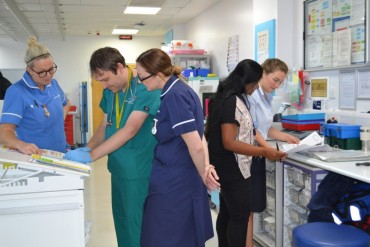What is intravenous sedation?
This is when you receive a drug to sedate you while you have your dental treatment. The drug makes you feel sleepy and relaxed but you will not be unconscious. It is given by your dentist, or by another dentist or a doctor.
Why should I have intravenous sedation?
Having sedation this way helps reduce any worry or anxiety you have about having your teeth treated. It can also help if you need a very long procedure or a painful procedure, such as having a tooth out.
The information provided here is a general guide for all patients having intravenous sedation. Your dentist will discuss with you your specific treatment plan and some of the advice described might not be relevant to the treatment you are going to have.
Nothing will happen until you and your parent or guardian understand and agree what has been planned for you. You will be able to discuss the treatment with your dentist. Your parent or guardian will need to be with you on the day of the treatment to sign the consent form, even if it was signed at an assessment visit.
Getting ready for your sedation
Before you have intravenous sedation, the dentist will ask you about your general health. If you have any long-term medical problems, the dentist will discuss these with you and your parent or guardian. The dentist will have also checked your height, weight, blood pressure (taken with a cuff that wraps around your arm) and oxygen levels in your blood, using a clip that attaches to your finger. On the day of the treatment, you should take any regular medicines and bring your medicines or inhalers with you.
If you have a cold or feel unwell, you or your parent/guardian will need to tell the dentist as you need to be as healthy as possible on the day of treatment.
If you think you may be pregnant, you need to let the dentist know. You may need to come back to have your treatment at another time.
Leave all jewellery and valuables at home. Do not wear excessive make up or any nail polish to the appointment. These can interfere with the monitoring equipment that is used while you are sedated.
Your dentist will discuss with you and explain what you are able to eat and drink prior to your appointment. You will also be given this information in writing. It is important that these instructions are followed carefully.
You will be asked to turn off your mobile phone during the appointment.
Wear loose, comfortable clothing and flat shoes. If you wear contact lenses, you may need to remove them. You may need to bring your glasses or spare lenses to wear after the appointment.
Your dentist or a member of the dental team may put an anaesthetic cream on the back of your hand or on your arm about 45–60 minutes before the appointment. You may be asked to do this at home, before you come to the dental surgery.
The cream makes the skin on your hand or arm go numb. The dentist (or doctor who will be helping with the sedation) will then place a cannula in a vein in your hand or arm. A cannula is a thin flexible tube. A needle is used to put the cannula in. The needle is then removed straight away but the cannula stays inside the vein.
The anaesthetic cream placed on the hand or arm helps reduce the discomfort of having the cannula inserted. Once the cannula is in the vein, the sedation drug can be injected through it without using any more needles.
The cannula is left in until the dentist (or doctor) allows you to go home. He or she will check that you have recovered properly from the sedation before letting you leave the dental surgery.
Your parent or guardian will be with you until the sedative drug is given and will then usually wait for you outside the surgery while your teeth are treated.
Once you are sedated, and feel drowsy and relaxed, the dentist can use local analgesia (pain relief that numbs the site of the dental treatment). Local anaesthetic as a paste is sometimes used to numb the site of the treatment. Any injections that you may need can then be given through this numbed area to reduce the chance of any discomfort.
A small clip will be put on your finger to measure your heart rate and the level of oxygen in your blood. Your blood pressure will be taken while you are sedated.
You will feel drowsy and sleepy during the treatment. Afterwards you may not remember very much about the treatment.
You may be moved to another area to recover fully. The dental team will decide when it is safe for you go home. You will need to rest at home. You cannot go home on your own – your parent, guardian or other responsible adult will need to stay with you for the rest of the day.
You may feel sick or drowsy. You may have a bruise where the cannula was. Your mouth may still feel numb or tingly for up to 3 hours. You will need to be careful not to bite your lip or cheek while it is numb.
You will need to avoid any strenuous exercise like riding a bike, driving a car or motorbike, playing active sports or training until at least the following day. Sometimes you may need to avoid these things for 24 hours but your dentist will advise you.
You should be careful about what you write or text on social media after your treatment as you may be a bit muddled and lack judgement.
Are there any risks to intravenous sedation I should know about?
Intravenous sedation is widely used but, as with taking any medicines, there are risks. Your dentist and members of the dental team are trained to give sedation. They watch you closely and treat any problems that may develop. The key risks are:
• A reduction of oxygen in the blood stream due to poor breathing during sedation. You may be asked by the dentist/sedationist to take deep breaths to correct this. Your breathing and oxygen levels will be monitored throughout the procedure.
• Bruising at the site of the cannula. This may take several days to fade completely.
Very rare risks are allergic reactions to the sedative drugs that you have been given or vomiting during the procedure. Your dentist/ sedationist will discuss any concerns that you may have prior to the procedure taking place.
Before you are discharged, you will be given information about pain relief as well as how and when to take any prescription medicines. You will be given information relating to any local analgesia and the treatment you have received. You or your parent/guardian will be given a telephone number of who to contact if you have any concerns.
Information from Standards for Conscious Sedation in the Provision of Dental Care (V1.1). 2020. The dental faculties of the Royal College of Surgeons and the Royal College of Anaesthetists.



